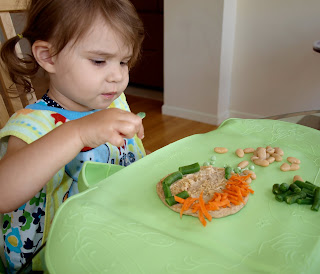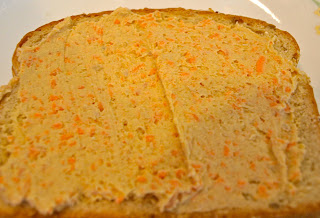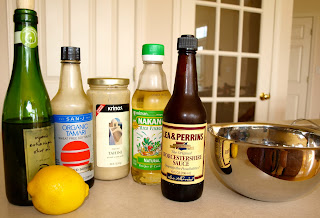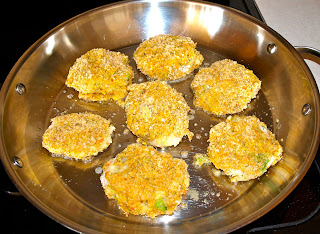I love Mexican food, but don't make it that often because Tim is just not that big of a fan. He says he just tolerates it, but I think he does secretly enjoy the flavors of good Mexican food. He likes Chipotle, does that count?
Unfortunately my favorite Mexican meals are not all that healthy--especially heavy on the cheese. And what is it about Mexican restaurants? The portions are gargantuan! So my mission was to create a healthy Mexican meal that kept portion sizes in check. I've been on a
Veganomicon kick lately, so I started there. I found a tasty-sounding recipe called Mexican Millet. Many of the ingredients I had on hand. Good start.
If you aren't familiar with millet, it is a healthy whole grain that actually looks a lot like quinoa. You already know that whole grains are good for your heart, but millet is also a good source of important nutrients likes phosphorus and magnesium. It's always good to mix it up and get a
variety of whole grains in your diet--not just the standard whole wheat pasta and brown rice. You can pick it up in the grain section of most supermarkets. Tangent over.
After deciding on the Mexican Millet from
Veganomicon, I continued my menu planning. There's a bean and corn salad that I often make. The original recipe is from
allrecipes.com , but it uses canned corn. It's a shame to use canned corn when the fresh corn is ripe for the pickin'! So I decided to switch it up a bit and use fresh corn. Usually we use this recipe as a dip for our tortilla chips, but thought it would make a scrumptious filling for some whole wheat tortillas I had in the pantry.
The result was a stand-up-and-clap meal. Okay, maybe it wasn't really worth standing up and cheering, but it was darn good.
Mexican Millet
adapted from Veganomicon
2 tablespoons coconut oil
1 clove garlic, minced
1 cup millet
1 small yellow onion, diced finely
1 jalepeno, seeded and minced
2 cups vegetable broth
3 tablespoons tomato paste
1/2 teaspoon salt
1/4 teaspoon ground cumin
2 tablespoons finely chopped cilantro
Freshly squeezed lime juice
Step 1: Heat the oil and garlic in a medium-size, heavy-bottomed saucepan over medium heat. Let the garlic start to sizzle, and then add the onion and jalapeno. Stir-fry until the onion gets soft and starts to turn golden, about 6-8 minutes.
Step 2: Add the millet, stir, and saute for 4-6 minutes, until the millet turns lightly golden.
Step 3: Pour in the vegetable broth, tomato paste, salt, and cumin.
Step 4: Bring the mixture to a boil, stir once, and cover. Lower the heat to low and cook for 25-30 minutes, until the liquid is absorbed.
Step 5: Once the liquid is absorbed, remove from heat and allow to sit, covered for about 10 minutes.
Step 6: Sprinkle with the chopped cilantro and fluff the millet with a fork. Squeeze fresh lime juice over each serving.
Sorry I have no pictures of this process. I was stressing to get dinner ready and didn't think to stop and take pictures. I do have a picture of the final plate--see below.
Black Bean and Fresh Corn Salad
adapted from allrecipes.com
1/4 cup balsamic vinegar
2 tablespoons olive oil
1/2 teaspoon salt
1/2 teaspoon
Sucanat (or you can use regular old refined white sugar)
1/2 teaspoon ground black pepper
1/2 teaspoon ground cumin
1/2 teaspoon chili powder
3 tablespoons chopped fresh cilantro
1 1/2 cups cooked black beans, or 1 (15 ounce) can, rinsed and drained
1 1/2 cups fresh corn, cut from the cob (I used 2 cobs. If you don't have any fresh, go ahead and use canned sweet corn)
Step 1: Bring a small pot of water to a boil. ~Meanwhile~In a small bowl, whisk together the first eight ingredients. Set aside.
Step 2: Cut the corn from the cob. (I used my chef's knife to do this--it's really easy)
Step 3: Once the water is boiling, put the corn in the water and let it boil for about 2-3 minutes. Drain and rinse with cold water.
Step 4: In a medium bowl, stir together black beans and corn. Toss with vinegar and oil dressing.
This salad is best if you can make it the night before and refrigerate overnight. If you can't do that, do it at least an hour ahead of time to give the flavors a chance to meld. Just think, if you do it overnight, dinner will come together in a snap! This salad is amazingly good and very versatile. Besides the two uses I described above, it can also be used as a topping for a lettuce salad. Be happy if you have leftovers.
Here's the final plate.
The picture doesn't do the tortillas justice. I used small whole wheat tortillas that I had warmed in the oven and filled them with the corn and bean salad. (I warmed up the salad in the oven as well because I wanted a warm tortilla--I'm sure it would be good cold, too) That's it! You could add cheese or whatever, but I don't think it's necessary. The salad has plenty of flavor and texture.
The millet was spicy. Now my palette is somewhat weak in the spice area, so some of you might think this dish doesn't bring much heat, but both Tim and I thought it was hot. In a good way. I put some on Meghan's plate, not sure if it would be too hot for her or not. She tried a few bites and when I asked if she liked it she shook her head yes. There were no complaints about its hotness, so I guess she handled it just fine. She didn't eat that much of it, though.
Tim thought the meal would be better if the millet was mixed in with the corn and bean salad, so that's what he did. I tried it for lunch today (gotta love leftovers!) and he was right. The salad has a sweetness about it that paired nicely with the spice of the millet.
I mixed in a little guac with my lunch. Another great addition. There are still leftovers in the fridge, so this recipe makes a good amount of food. If you have a big family, you'll feed 'em all, if not you can have this for dinner a few nights in a row or have your lunches covered for a few days. :-)










































